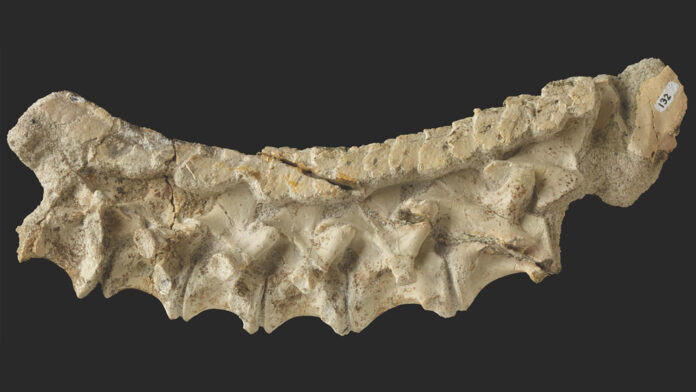Archosaurs are reptiles that are divided into two major branches: “bird-line,” which includes pterosaurs and dinosaurs, including living dinosaurs (birds), and “crocodilian-line,” including crocodiles, alligators, caimans, and gharials. Understanding the evolution of the earliest avemetatarsalian (bird-line) archosaurs and inferring the morphology of the last common ancestor of Archosauria are hampered by a poor fossil record in critical temporal intervals.
A new species of armored reptile that lived close to the time of the onset of dinosaurs has been reported by researchers. This archosaur fossil, which has bony plates on its backbone, shows that armor was a boomerang trait in the evolution of dinosaurs and pterosaurs. The group’s ancestors had armor, but it was lost and later independently re-evolved numerous times in specialized dinosaurs like ankylosaurs and stegosaurs.
Mambachiton fiandohana, a recently discovered archosaur species, is the earliest diverging member of the archosaur species. A team of researchers found the fossil-originally in 1997- which dates back about 235 million years. Its discovery highlights the importance of the southern hemisphere fossil record in understanding this crucial Triassic period when dinosaurs first appeared.
The study’s lead author Sterling Nesbitt, associate professor of geosciences at Virginia Tech and a research associate in the American Museum of Natural History‘s Division of Paleontology, said, “We are just starting to understand that there were many dinosaur-like creatures across the planet well before dinosaurs evolved. Dinosaurs were latecomers to the Triassic reptile party. They showed up well after many dinosaur-looking reptiles were established across our planet.”
Based on the fossil, researchers assumed the size and shape of the Mambachiton. Mambachiton is thought to have been between 25 and 45 pounds (10 and 20 kilograms) in weight and 4-6 feet (1.5-2 meters) long. Unexpectedly, the species featured a thick layer of osteoderms, bony plates that coat the backbone. Apart from dinosaurs like stegosaurs, ankylosaurs, titanosaur sauropods, and at least one theropod, osteoderms are uncommon in bird-line archosaurs, although they are frequent in crocodilians and their relatives.
Mambachiton conclusively demonstrates that the bird-line archosaur clade had armored ancestors. This armor was lost when dinosaurs and pterosaurs evolved, but it eventually made numerous independent reappearances in the dinosaur lineage.
Co-author Christian Kammerer, a former Gerstner Scholar at the Museum and a research curator in paleontology at the North Carolina Museum of Natural Sciences, said, “The loss and re-evolution of armor is an important aspect of the story of dinosaur evolution—freeing them from some of the biomechanical body constraints of the ancestral archosaurs and potentially contributing to some of the locomotor shifts as dinosaurs diversified into a dizzying array of different ecology and body forms.”
Project co-leader Lovasoa Ranivoharimanana of the University of Antananarivo said, “Mambachiton demonstrates that retention of ancestral features or acquisition of new traits depends on interactions within the ecosystem.”
“When a character is essential, it is retained, but when it is no longer useful, it disappears.”
Journal Reference:
- Sterling J Nesbitt, Emily Patellos et al. The earliest-diverging avemetatarsalian: a new osteoderm-bearing taxon from the Triassic (?Earliest Late Triassic) of Madagascar and the composition of avemetatarsalian assemblages prior to the radiation of dinosaurs. Zoological Journal of the Linnean Society, zlad038, DOI: 10.1093/zoolinnean/zlad038
